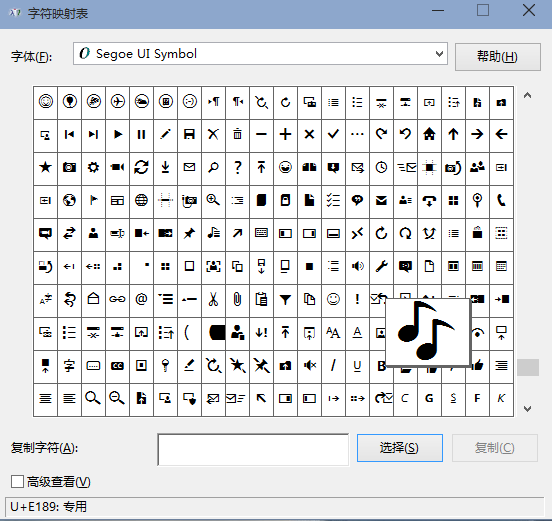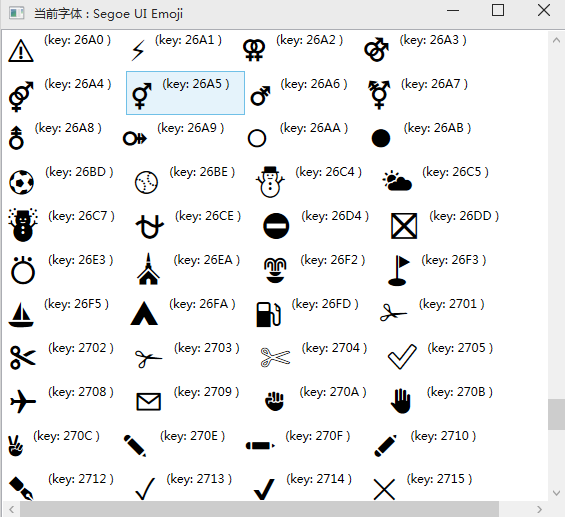目前的软件开发中,很多地方都使用到了矢量图标,在 Metro app 的开发中,可以使用 Windows
系统图标(02、Universal app 中按钮图标使用 ),包括 Segoe UI Symbol、Segoe MDL2 Assets(Windows10 新添加)、
Segoe UI Emoji 等。
不过在开发中,遇到了一个问题,就是系统自带的 “字符映射表” 中很多图标太小了,又不能调整大小
,不方便浏览,于是自己动手写了一个矢量图形的 Unicode 查询工具(使用 WPF 写的),涉及到了 Unicode
转码的一些技术。
系统自带的 “字符映射表” :

1、"矢量图形查询工具" 运行效果:
1)主窗口:

2) 可以同时打开 Segoe UI Emoji 窗口:

Segoe UI Symbol 窗口:

Segoe MDL2 Assets 窗口:

2、不同编码,占用的字节关系:
1)ASCII码:一个英文字母(不分大小写)占一个字节的空间,一个中文汉字占两个字节的空间。
UTF-8编码:一个英文字符等于一个字节,一个中文(含繁体)等于三个字节。
Unicode编码:一个英文等于两个字节,一个中文(含繁体)等于两个字节。
符号:英文标点占一个字节,中文标点占两个字节。举例:英文句号“.”占1个字节的大小,中文句号“。”占2个字节的大小。
2)示例:在代码和 xml 中表示 unicode:
<Label Content="示例:" Grid.Row="5"/>
<StackPanel Orientation="Horizontal" Grid.Row="5" Grid.Column="1">
<!--将字符的 Unicode 的写在 xml 文件中时,需要使用转码格式-->
<TextBlock FontFamily="Segoe UI Symbol" Text=""/>
<!--在 C# 页面中,用代码赋值-->
<TextBlock FontFamily="Segoe UI Symbol" x:Name="txtSample" Margin="30,0,0,0"/>
</StackPanel>
在 C# 代码中(与 C++ 表示方式相同),unicode 书写的格式为以 '\u' 开头(注意 u 为小写),后面是大于4位的 十六进制数,格式需要正确:
txtSample.Text = "\uE189";
显示效果:

如果格式不对,不会通过编译:

3、遍历当前 Windows系统上安装的所有字体:
1)首页 MainWindow.xaml 中的代码:
<Label Content="所有字体:" Grid.Row="1"/>
<ComboBox x:Name="fullFamily" Grid.Row="1" Grid.Column="1">
<ComboBox.ItemsPanel>
<ItemsPanelTemplate>
<VirtualizingStackPanel/>
</ItemsPanelTemplate>
</ComboBox.ItemsPanel>
<ComboBox.ItemTemplate>
<DataTemplate>
<TextBlock Text="{Binding}" Margin="30,5,0,0" Background="Transparent"/>
</DataTemplate>
</ComboBox.ItemTemplate>
</ComboBox>
<Label Content="打开查询窗口:" Grid.Row="3"/>
<ListBox x:Name="listBox" Grid.Row="3" Grid.Column="1">
<ListBox.ItemTemplate>
<DataTemplate>
<TextBlock Text="{Binding}" MouseLeftButtonDown="TextBlock_MouseLeftButtonDown" Margin="30,5,0,0" Background="Transparent"/>
</DataTemplate>
</ListBox.ItemTemplate>
</ListBox>
2)C# 页面代码:
private void MainWindow_Loaded(object sender, RoutedEventArgs e)
{
FontFamilyMapCollection ffCollection;
// 遍历当前系统上的所有字体。参考 MSDN:
// https://msdn.microsoft.com/zh-cn/library/system.windows.media.fontfamily.aspx
foreach (FontFamily fontFamily in Fonts.SystemFontFamilies)
{
// 这里把 “图标字体”显示到 ListBox 中,“所有字体” 显示到 ComboBox 中
if (fontFamily.Source == "Segoe UI Symbol" || fontFamily.Source == "Segoe MDL2 Assets" || fontFamily.Source == "Segoe UI Emoji")
{
ffCollection = fontFamily.FamilyMaps;
listBox.Items.Add(fontFamily.Source);
}
fullFamily.Items.Add(fontFamily.Source);
}
}
// 选中相应 “图标字体” 后,跳转到 “查看窗口”
private void TextBlock_MouseLeftButtonDown(object sender, MouseButtonEventArgs e)
{
string fontName = (sender as TextBlock).Text;
SymbolWindow sw = new SymbolWindow();
// 使用静态属性,作为参数传递
SymbolWindow.CurrentFontFamily = new FontFamily(fontName); // 选中的字体
sw.Show();
}
4、浏览窗口:
1)SymbolWindow.xaml 文件 ,窗口的 x:Name 设置为 myWindow :
<ListView x:Name="listBox" ItemTemplate="{StaticResource template}">
<ListView.ItemsPanel>
<ItemsPanelTemplate>
<!--Items 面板的宽度与窗口宽度绑定,根据窗口改变排列。防止显示为单行-->
<WrapPanel Orientation="Horizontal" Width="{Binding ActualWidth,ElementName=myWindow}"/>
</ItemsPanelTemplate>
</ListView.ItemsPanel>
</ListView>
2)在 this.Loaded 事件中,调用 FontItem.EnumeratorFontFamily(CurrentFontFamily) 静态方法,把相关字体中
包含的所有 Unicode 编码转换为相应的 字符:
/// <summary>
/// 作为从 MainWindow.xaml 传递来的参数
/// </summary>
public static FontFamily CurrentFontFamily;
private void Segoe_UI_Symbol_Loaded(object sender, RoutedEventArgs e)
{
// FontFamily ff = new FontFamily("Segoe MDL2 Assets");
if (CurrentFontFamily != null)
{
this.FontFamily = CurrentFontFamily;
this.Title = " 当前字体 : " + CurrentFontFamily.Source;
listBox.ItemsSource = FontItem.EnumeratorFontFamily(CurrentFontFamily);
}
}
5、FontItem 类定义,用来显示绑定和 Unicode 的转码:
1)把十六进制 unicode 转换为 byte 数组,再调用 Encoding.Unicode.GetChars(array); 方法,转换为
相应字符:
// Unicode 转换为 “符号” 字符表示
// 例如,0xE189 转换为 byte[]{ 137, 225 }
byte[] bytes = new byte[]
{
(byte) Key,
(byte) (Key >> 8)
};
string Character = ByteToString(bytes);
// 把二进制数转换成字符
public static string ByteToString(byte[] array)
{
var enc = Encoding.Unicode;
var chars = enc.GetChars(array);
return new string(chars);
}
FontItem.cs 文件 全部代码:
class FontItem
{
public string key { set; get; }
public string value { get; set; }
public string font { set; get; }
public static List<FontItem> EnumeratorFontFamily(FontFamily family)
{
Dictionary<int, FontItem> fonts = new Dictionary<int, FontItem>();
var typefaces = family.GetTypefaces();
foreach (Typeface typeface in typefaces)
{
// 对应字体文件中包含的物理字体
GlyphTypeface glyph;
typeface.TryGetGlyphTypeface(out glyph);
// 根据字体“CMAP”表的定义获取 Unicode 码位与标志符号索引之间的名义映射。
IDictionary<int, ushort> characterMap = glyph.CharacterToGlyphMap;
foreach (KeyValuePair<int, ushort> kvp in characterMap)
{
// Console.WriteLine(String.Format("{0}:{1}", kvp.Key, kvp.Value));
int Key = kvp.Key; // 没有用到 kvp.Value
// 如果大于 0xffff(为空字符,显示为小方框),则跳出循环
if (Key > 0xffff) // 0 ~ 65535
{
break;
}
// 方法 1: Unicode 转换为 “符号” 字符表示
// 例如,0xE189 转换为 byte[]{ 137, 225 }
byte[] bytes = new byte[]
{
(byte) Key,
(byte) (Key >> 8)
};
string Character = ByteToString(bytes);
// 方法 2:Unicode 转换为 “符号” 字符
// 可以用来转换 Key= 65535 以下的 Unicode,如果大于 65535,则会抛出:
// “ System.OverflowException:值对于字符太大或太小” 的异常
// char c = Convert.ToChar(Key);
// string Character = c.ToString();
// 过滤掉空字符
if (!string.IsNullOrEmpty(Character) &&
!string.IsNullOrWhiteSpace(Character) &&
!fonts.Keys.Contains(Key)// 去掉重复的
)
{
fonts.Add(Key, new FontItem { key = Key.ToString("X4"), font = Character });
}
}
}
return fonts.Values.ToList();
}
// 把二进制数转换成字符
public static string ByteToString(byte[] array)
{
var enc = Encoding.Unicode;
var chars = enc.GetChars(array);
return new string(chars);
}
}
View Code
工具直接下载 (基于 .net framework 4.5)
源代码下载
参考及相关阅读:
How to: Enumerate Installed Fonts
字体文件中包含的字符判断
百度百科:Unicode